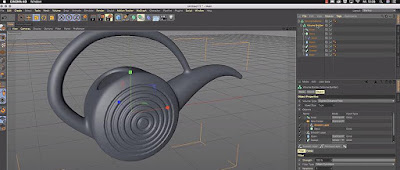To create a model in cinema 4D you’re constantly switching among the drawing tools, views and components. In this article, you find several examples that illustrate ways you can use these tools together to model a specific shape or object.
- Choose Create > Object> Torus from the menu bar and create a torus with a radius of about 394 cm and enough Pipe segments and Ring Segments for smoothness, refer to Figure 1.
Figure:1
- Choose Create > Object> Sphere from the menu bar and create a sphere with a radius of about 46 cm and enough segments.
- Scale sphere vertically and align with torus as shown in Figure 2.Figure:2
- Create one more sphere with radius of about 18 cm, scale and align it with first sphere, refer to Figure 3.
Figure:3 - Create another torus with radius of 450cm & align it with the first torus, as shown in Figure 4.
Figure:4 - Create one more sphere of radius 10cm.
- Next, choose MoGraph > Cloner from menu bar
- In the Object Manager, select the last sphere created (radius =10) and drag it to Cloner, as shown Figure 5.
Figure:5 - Select Cloner in the Object Manager and set the parameters in the Attribute Manager, as shown in Figure 6.
Figure:6 - You will notice that cloned spheres are arranged radially around torus as shown in Figure 7.
Figure:7 - Choose Volume > Volume Builder from menu bar
- Now, drag all the objects one by one to Volume Builder in the Object Manager, as shown in Figure 8.
- Choose Volume > Volume Mesher from menu bar
- In the Object Manager, drag Volume Builder to Volume Mesher.
Figure:8 - Choose the Render to Picture Viewer tool; rendered view of ring is displayed, as shown in Figure 9.
Figure:9
You can use the tips & techniques demonstrated in these ring model example.To order MAXON CINEMA 4D R20 Studio: A Tutorial Approach, 7th Edition Book, please visit the following links:-












